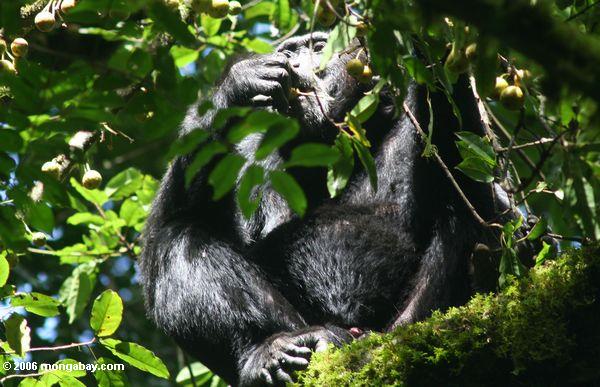Study finds chimps at high risk for epidemics
The year was 1854, and cholera outbreaks had rendered London terrified and British anesthesiologist Dr. John Snow fascinated. In what is thought to be the first epidemiological study, Dr. Snow carefully mapped the locations of the victims and tried to find a common denominator.
“I found,” he wrote afterwards, “that nearly all the deaths had taken place within a short distance of the [Broad Street] pump.”
In what is now known as Snow’s “Grand Experiment,” he not only discovered how cholera had spread (through what he described as “white, flocculent particles” in the pump’s water), but, by removing the pump, he was able to put a stop to the outbreak.

Chimpanzees (Pan troglodytes) have declined throughout their range and have disappeared entirely from four African countries. Photo by Thomas Lersch.
Over 160 years later, Dr. Snow’s techniques are still being used in the field of epidemiology. In a nine-year-long study published recently in PLOS ONE, five researchers added modern technology to John Snow’s observational studies in an attempt to understand how diseases spread and differ among orangutans (Pongo pygmaeus wurmbii) and chimpanzees (Pan troglodytes schweinfurthii), creating the first-ever epidemiological model for great ape populations.
Of all the threats that great apes face, infectious disease is one of the most significant. These two species are both listed as Endangered by the IUCN, and are at risk for extinction. Because of this, any information about dangers to their populations is important. Diseases such as Ebola, mange, tuberculosis, scabies, and measles are among the most dangerous.
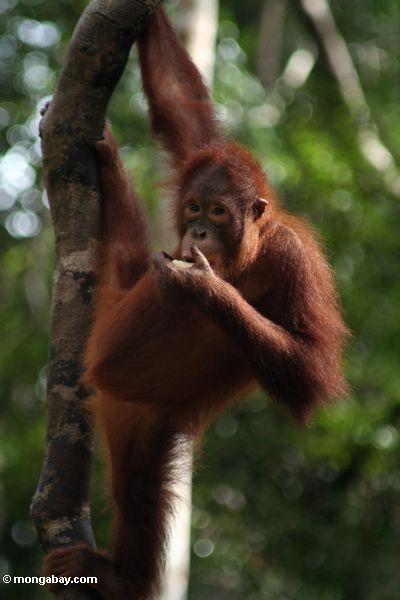 A Bornean orangutan (Pongo pygmaeus)in Kalimantan. Bornean orangutans have declined 50 percent throughout their range over the past 50 years. The Sumatran species (P. abelii) has declined 80 percent. Photo by Rhett A. Butler. |
Behavior-wise, chimpanzees and orangutans are very different. While chimps are highly social and exist in relatively large groups, orangutans are often solitary, or form groups with offspring only. By studying the social patterns of orangutans living in the Sabangau Forest of Central Kalimantan, Indonesia, and chimpanzees living in Budongo Forest, Uganda, the team of environmental anthropologists and conservationists began to track how diseases spread through their populations.
The going was slow: it took nine years to gather enough data on the orangutan population, and three years to collect information on the chimpanzees. The team focused on disease transmission from ape-to-ape, or from close proximity to other animals. Using focal follows – observing and recording behavior – the researchers were able to compile an epidemiological model with which to run simulations.
Using the models, researchers were able to simulate a disease within the two populations. Randomly selecting an animal to be the first infected “patient zero,” the algorithm simulated the spread of the pathogen based on the population and interaction data gathered in the field. The scientists also used various values for the probability of recovery and a “transmission coefficient,” measuring how easily the disease would spread.
The simulations ended when the disease effectively stopped spreading, and all the apes had recovered. Then, the total number of infected apes would be counted up and used to calculate the scale of the epidemic.
With the more solitary orangutan population, researchers found that disease did not spread quickly or very far. Even with an extremely low recovery probability and an extremely high transmission coefficient, the team found that only an average of 14 percent of the population became infected.
A chimpanzee in Uganda. Photo by Rhett A. Butler.
Conversely, the more social chimpanzees were at a significantly higher risk of infection. Even with a high probability of recovery and a low transmission coefficient, disease spread quickly throughout chimp population, resulting in an almost 18 percent infection rate. These results showed that the chimpanzees were much more vulnerable to epidemics than their orangutan counterparts.
For conservationists, this information gives valuable insight into one of the great apes’ most dire threats and may allow for more effective management of threatened populations. While orangutans are not exactly safe from disease, chimpanzees are much more at-risk, and the study suggests that effort should be focused on barring diseases from entering the population to avoid possible epidemics like that which Dr. Snow discovered in nineteenth-century London.
Because of chimpanzees’ gregarious nature, they are more likely to come into contact with infected individuals, or even with infected human tourists. The less-susceptible orangutans have comparatively less contact with the outside world, and are so in comparatively less danger from disease – although it should be said any loss in their numbers would have damaging effects on their already small and fragmented populations.
Increased human contact through ecotourism and logging, as well as shrinking habitats, may force great ape populations closer together, heightening the chances of an epidemic. Although this epidemiological model doesn’t have an answer as easy as simply removing the Broad Street pump, the information uncovered by this study may improve future conservation efforts for these iconic and endangered great apes.

A Bornean orangutan. Photo by Rhett A. Butler.
Citations:
- Carne, Charlotte, Stuart Semple, Helen Morrogh-Bernard, Klaus Zuberbühler, and Julia Lehmann. “The Risk of Disease to Great Apes: Simulating Disease Spread in Orang-Utan (Pongo Pygmaeus Wurmbii) and Chimpanzee (Pan Troglodytes Schweinfurthii) Association Networks.” Plos One 9.4 (2014): n. pag. 16 Apr. 2014. Web.
Related articles
What does SOCO’s withdrawal really mean for the future of Virunga National Park?
(06/17/2014) Recent headlines have touted an agreement between SOCO International, a British oil company, and WWF, as bringing about an end to oil exploration in Virunga National Park. For example: Oil company Soco not to drill in Virunga World Heritage Site, Deal aims to ban drilling in gorilla preserve, and Soco halts oil exploration in Africa’s Virunga national park. However, the same news banners flew in 2011, and oil exploration returned.
Extractive industries and apes
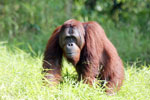
(06/13/2014) Current thinking in the private and public sectors asserts that economic development needs are in conflict with, or mutually exclusive of, the need to conserve the biosphere on which we depend. So, we are asked either to reduce development in the name of conservation or to reduce conservation in the name of development.
What’s an environmental journalist to do with so much good news?
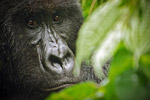
(06/12/2014) As an environmental journalist covering stories from the great Arctic ice melt to the rhino poaching crisis in Africa, you’ll forgive me if sometimes in the morning—before I turn my computer on—I have a sudden desire to spend a few extra minutes in bed or have a leisurely breakfast with my daughter or just sit in the back yard with a cup of tea and a good book.
Oil overthrow: Soco to suspend operations in Virunga National Park after sustained campaign by WWF
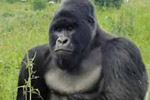
(06/11/2014) In a surprise announcement, British oil company Soco International has said it will suspend exploratory operations in Virunga National Park, home to half the world’s Critically Endangered mountain gorillas as well as thousands of other species. The announcement follows several years of campaigning from conservation groups led by WWF.
Greenpeace accuses controversial palm oil company and Cameroon government of illegal logging

(05/28/2014) Greenpeace has just accused one of the world’s most controversial oil palm companies, Herakles Farms, of colluding with top government officials to sell off illegally logged timber to China. According to a new report, an agreement between Cameroon’s Minister of Forestry and Herkales Farms—through a shell company—could torpedo the country’s agreement with the EU for better timber management.
Hope in the Heart of Darkness: huge population of chimpanzees discovered in the DRC

(05/20/2014) A recent study describes a new population of chimpanzees, which forms a continuous cultural group inhabiting an area of at least 50,000 square kilometers (19,000 square miles). The population, estimated to consist of many thousands of individuals, shares a unique set of learned skills that are passed on from generation to generation.
